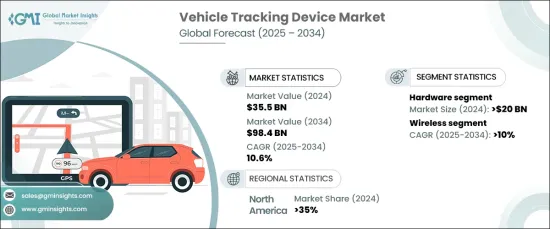
세계의 차량 추적 장치 시장은 2024년 355억 달러에 달했으며, 2025년부터 2034년까지 연평균 성장률(CAGR) 10.6%로 성장할 것으로 예측됩니다.
이러한 급속한 성장은 차량 관리에서 실시간 추적 솔루션에 대한 수요 증가, 차량 도난에 대한 우려 증가, 다양한 산업 분야에서 첨단 텔레매틱스 기술 채택 증가에 힘입은 바가 큽니다. 기업이 운영 효율성, 보안, 비용 관리를 우선시함에 따라 차량 추적 장치는 자산 모니터링, 경로 최적화, 차량 및 물품의 안전 보장에 필수적인 도구가 되었습니다. 실제로 이러한 장치의 기능을 강화하기 위한 전략적 파트너십이 등장하고 있습니다. 예를 들어, 2024년 3월, HERE Technologies는 호주 상용차용 자산 관리 및 내비게이션 서비스를 개선하기 위해 Netstar와 제휴했습니다.

이러한 솔루션에 대한 관심이 높아지는 이유는 기업이 실시간 데이터를 수집하고 분석하여 더 나은 정보에 기반한 의사 결정을 내릴 수 있게 해주는 커넥티드 디바이스와 사물인터넷(IoT)의 급증에 기인합니다. 이러한 추세는 특히 추적 시스템이 상품의 적시 배송을 보장하는 데 필수적인 역할을 하는 물류와 대중교통 시스템과 같은 산업에서 두드러집니다. 소비자와 기업 모두 운영 효율성 향상, 보안, 적시 배송 등 차량 추적의 수많은 이점을 인식하고 있기 때문에 이 시장은 크게 성장할 것으로 예상됩니다. 특히 GPS 추적 장치는 2032년까지 약 90억 달러의 매출과 연간 성장률이 12%를 넘어설 것으로 예상되는 등 시장을 견인할 것으로 전망됩니다.
| 시장 범위 | |
|---|---|
| 시작 연도 | 2024년 |
| 예측 연도 | 2025-2034년 |
| 시작 금액 | 355억 달러 |
| 예측 금액 | 984억 달러 |
| CAGR | 10.6% |
차량 추적 장치 시장은 하드웨어와 소프트웨어 구성 요소로 나뉩니다. 2024년 하드웨어 부문은 200억 달러 이상의 가치를 차지했으며 계속해서 빠르게 확장되고 있습니다. 기업들이 자산 관리를 위한 안정적이고 효율적인 솔루션을 찾으면서 고품질 텔레매틱스 시스템과 GPS 장치에 대한 수요가 증가함에 따라 이러한 성장을 주도하고 있습니다. 특히 2024년 6월 모니모토가 출시한 모니모토 9와 같은 GPS 추적 기술의 발전은 혁신에 대한 업계의 노력을 보여줍니다. 이 새로운 버전은 오토바이, 보트, 트레일러 등 다양한 자산에 대한 보호 기능을 강화했습니다.
또한 시장은 연결성별로 분류되며, 무선 추적 장치는 2025년부터 2034년까지 10% 이상의 연평균 성장률을 기록할 것으로 예상됩니다. 무선 부문의 성장은 주로 설치의 용이성, 확장성 및 실시간 데이터 기능에 기인합니다. 또한 IoT 애플리케이션의 지속적인 개발은 기업이 고급 추적 기능을 활용하고 더 나은 데이터 분석과 원격 모니터링을 통해 운영을 최적화할 수 있도록 하는 원동력이 되고 있습니다.
북미 지역은 2024년 전 세계 차량 추적 장치 시장의 35% 이상을 차지할 것으로 예상됩니다. 이러한 우위는 주로 엄격한 규제와 잘 정립된 물류 부문에 기인합니다. 북미 지역은 차량 관리를 위한 실시간 추적 솔루션에 대한 의존도가 높기 때문에 기업들이 규제 요건을 충족하고 안전 기준을 강화하기 위해 텔레매틱스 시스템을 통합하면서 시장 수요를 지속적으로 촉진하고 있습니다.
The Global Vehicle Tracking Device Market was valued at USD 35.5 billion in 2024 and is projected to grow at a CAGR of 10.6% from 2025 to 2034. This rapid expansion is largely driven by the increasing demand for real-time tracking solutions in fleet management, heightened concerns about vehicle theft, and the rising adoption of advanced telematics technologies across a variety of industries. As businesses continue to prioritize operational efficiency, security, and cost management, vehicle tracking devices have become indispensable tools for monitoring assets, optimizing routes, and ensuring the safety of vehicles and goods. In fact, strategic partnerships are emerging to boost the capabilities of these devices. For example, in March 2024, HERE Technologies teamed up with Netstar to improve asset management and navigation services for commercial vehicles in Australia.

The growing interest in these solutions can be attributed to the surge in connected devices and the Internet of Things (IoT), which enable businesses to capture and analyze real-time data to make better-informed decisions. This trend is particularly significant in industries like logistics, where tracking systems play an essential role in ensuring the timely delivery of goods, as well as in public transport systems. With consumers and businesses alike recognizing the numerous advantages of vehicle tracking, such as enhanced operational efficiency, security, and timely deliveries, the market is poised for substantial growth. In particular, GPS tracking devices are expected to fuel the market, with a projected revenue of around USD 9 billion by 2032 and an annual growth rate surpassing 12%.
| Market Scope | |
|---|---|
| Start Year | 2024 |
| Forecast Year | 2025-2034 |
| Start Value | $35.5 Billion |
| Forecast Value | $98.4 Billion |
| CAGR | 10.6% |
The vehicle tracking device market is segmented into hardware and software components. In 2024, the hardware segment accounted for over USD 20 billion in value and continues to expand rapidly. The increasing demand for high-quality telematics systems and GPS devices is driving this growth as businesses seek reliable, efficient solutions for managing their assets. Notably, advancements in GPS tracking technology, such as Monimoto's release of the Monimoto 9 in June 2024, illustrate the industry's commitment to innovation. This new version provides enhanced protection for various assets, including motorcycles, boats, and trailers.
Additionally, the market is categorized by connectivity, with wireless tracking devices projected to experience a CAGR of over 10% from 2025 to 2034. The wireless segment's growth is mainly due to the ease of installation, scalability, and the real-time data capabilities it offers. The continuous development of IoT applications is also a driving force, enabling businesses to harness advanced tracking functionalities and optimize their operations through better data analytics and remote monitoring.
North America accounted for more than 35% of the global vehicle tracking device market in 2024. This dominance is primarily attributed to stringent regulations and a well-established logistics sector. The region's heavy reliance on real-time tracking solutions for fleet management continues to fuel market demand, with companies integrating telematics systems to meet regulatory requirements and enhance safety standards.